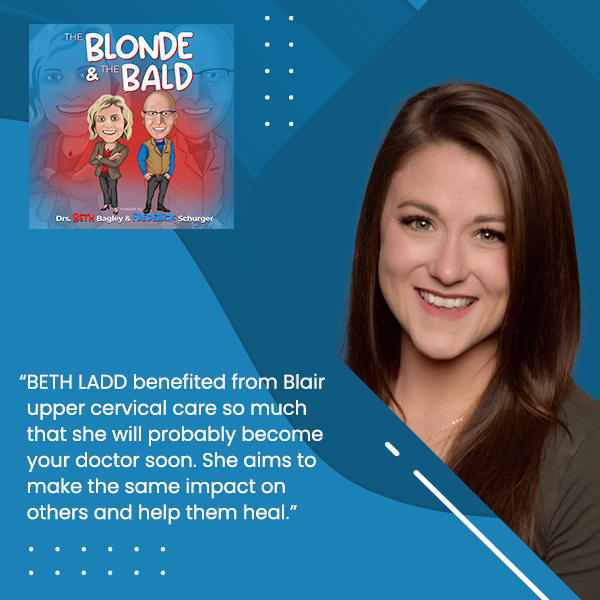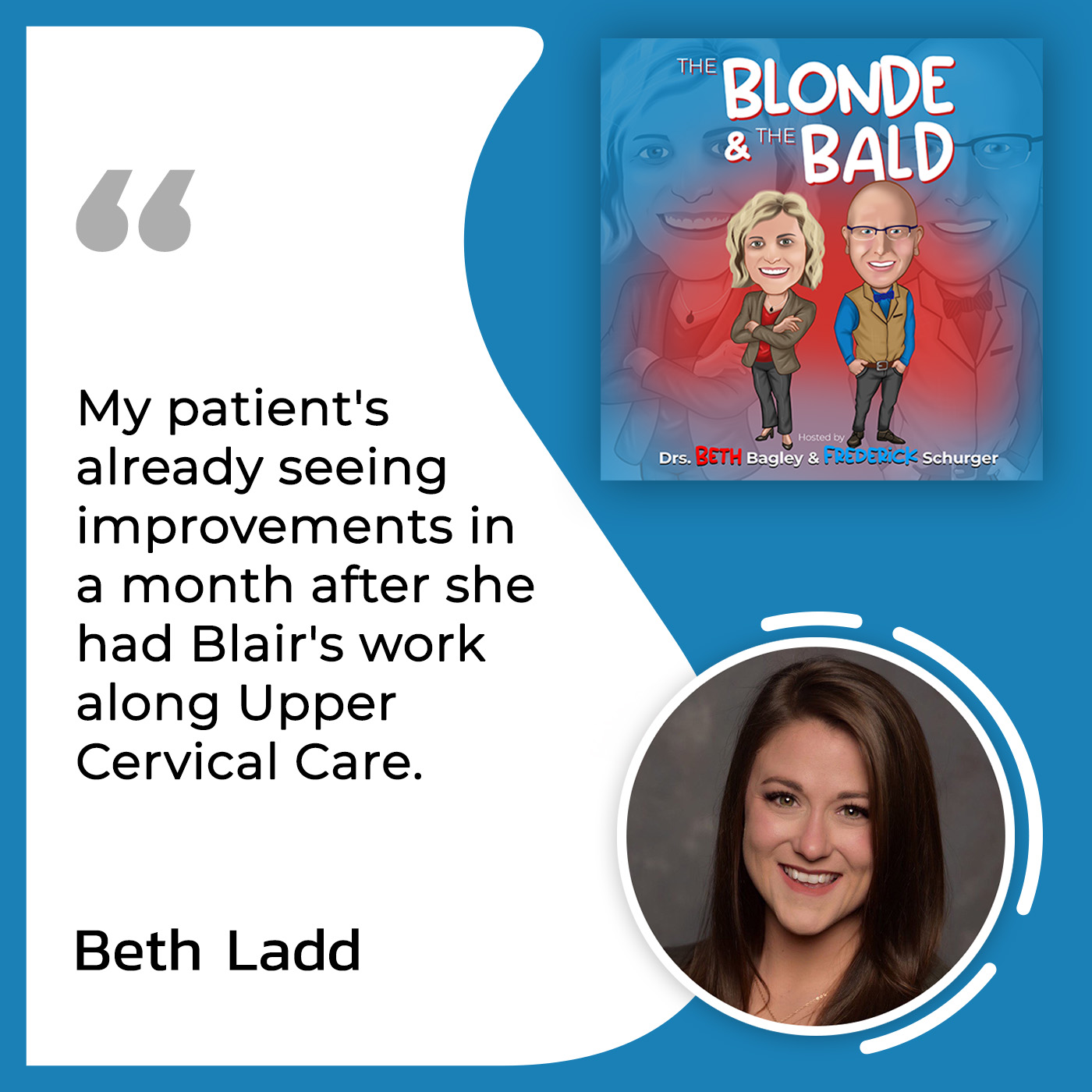
Today’s guest is your soon-to-be doctor, Beth Ladd. She talks about Bell’s Palsy and Collitis and how Upper Cervical Care changed her body. Diving deeper into the conversation, Dr. Bagley and Dr. Schurger also explain the need for an upright MRI to diagnose Chiari’s malformations. Even a small Chiari malformation can affect the cerebral spinal fluid flow. To wrap up this episode, Dr. Bagley and Dr. Schurger share some interesting research about thiamine helping fatigue. Let’s unpack so many insights coming from the Blonde and the Bald!
—
Watch the episode here
Listen to the podcast here
Bell’s Palsy, Collitis, Chiari & Thiamine!
I’ve got a special guest with me. It is almost Doctor Beth Ladd. Double Beths. We are both Beth.
Almost Dr. Ladd, this will come out in July 2023. You graduate what?
December 2023.
You’ve got a little bit of time there with Dr. Bagley yet, but I hear you’ve got a great story. Let’s get into that.
I started to come to Precision Chiropractic in March 2020 when everything started to fall apart. I lost my job and got Bell’s palsy in the same week. Bell’s palsy is when half of your face goes numb pretty much. You lose control over all your movements. Luckily, I knew somebody in the past who had Bell’s palsy and I knew how to do the stroke test. I’m like, “I’m not having a stroke but something is seriously wrong.”

I made an appointment with my primary physician. I went and got the medications that are typically prescribed, but thankfully, my mother was like, “That’s not enough. We’re going to find something else.” She found Dr. Bagley’s office. That’s how I learned about upper cervical care. I started coming here. I saw a ridiculous amount of improvement within six weeks. I was almost nearly healed from Bell’s palsy. A lot of people take three months to see what I saw. I saw the results of upper cervical chiropractic in that recovery. It was a blessing.
Did you see other changes too with other things that you had going on?
I saw an improvement in my menstruation. That became more regular. I also felt like I had more energy.
I’m going to ask a couple of things. With the Bell’s, do you still have any problems with that or do you have any muscles that aren’t moving the way they’re supposed to? Have you noticed that?
I feel like there’s a little bit of weakness still left like my eyebrow, but I feel it when I get stressed. Especially with chiropractic school, I got some stress with that and I would feel a weakness here that may not always be seen by other people but I could feel it. There were times when people told me, “That eyebrow looks low.” On a day-to-day basis, I typically don’t have any issues. The only other thing is I now have what I call Bell’s headaches. I never had a one-sided headache. They were always the neck pain and everything like that. Now, every once in a while, I’ll get a headache, where it’s just the right side of my face and that’s the same side that I was affected by the Bell’s.
Here’s the other question. Seems like you glossed over. You had problems with your cycle but was it bad beforehand? Did you even know that there was a problem with your cycle?
I’ve had issues since I was 18, maybe 17. I had gone on the pill previously. That got regulated. I had gone off the hill prior to coming here. I was going through the ups and downs of coming off of that hormone medication. I didn’t realize this until later but about a month or month and a half before I got Bell’s, I’d been working in a warehouse and I had a box fall on top of my head.
It wasn’t like falling from 10 feet up. It just slid off another box and landed on top of my head. I didn’t associate it with this but after that, I had some neck pain. As time went by, it got worse until the week before I got Bell’s, “I can’t deal with this. I have to figure something out.” I ended up going to a different chiropractor, a general chiropractor. He did a couple of adjustments and then I got the Bell’s.
The reason I asked specifically is there are so many people on it. One of the comments I’ve heard, and I’m certain you have too, especially in your short time, not only being around Dr. Bagley’s office but also treating patients is, “Is this normal? What’s normal?” People are like, “What I was dealing with was normal.” It wasn’t. People start complaining, “Doc, it hurts again.” I’m like, “Now you can feel it.”
She started seeing some of her own new patients and something similar happened where something started coming back. Tell him about the new patient that you saw.
I have a patient that has ulcerative colitis. She deals with some energy issues especially but her main concern was how frequently she had to use the restroom, and even made her nervous. Going places, she has to make sure that they have two bathrooms. She doesn’t feel comfortable going anywhere that doesn’t have two bathrooms because she’s worried about the emergency situation.
She had gotten upper cervical care before but hadn’t for a while, and she had Blair. She has been coming in for about a month. About a couple of weeks in, she got the normal treatment that she goes through. She was also getting upper cervical care along with that. After she got a treatment and a couple of adjustments, she said that she’s been very consistent about her bathroom use and that she’s had more energy. Her neck and shoulder discomfort are gone. The last few times, she’s held her adjustments. She’s already seeing those improvements in a month.

She came in and she’s had a dip.
She came and she’s like, “I have been so tired. My stomach has been feeling off.” What do you know? C1 was out.
There are a couple of things that could be going on with that average patient where even C1 might not be out in that case. After about four weeks, the body has gone through the healing process. Somewhere around that between weeks 4 and 6, the energy level gets sapped down. Symptoms start creeping back up because the body is in a process of inwardly healing. It’s like driving down a street that’s going through a little bit of construction. This is going to be a pain. You wait after a couple of weeks, the construction’s done, and now things are back to where they’re supposed to be.
It’s always exciting to see those kinds of cases and it’s great. For anyone who has decided to go eat at your favorite restaurant that sometimes has a little bit of problems. It rhymes with Bell. It also has Bell in the title. It might have tacos in the title but sometimes people eat there. Sometimes they’re like, “I know where I’m going right afterward.”
Why do people eat there?
I don’t understand that either. I don’t eat there anymore. If you’ve ever experienced that urgency, it is not something you want.
Imagine this woman, 6 or 7 times a day having urgency. It will consume your life. These digested disorders are terrible.
Your body’s trying to purge something and get rid of it. It’s not because it keeps on doing it over and over again. That’s exciting that the central part of the nervous system, the brainstem where the atlas is that we are correcting is now getting her body working the way it’s supposed to. That’s awesome. Almost Dr. Ladd needs to leave.
We’ll reconvene in a second. Thanks for coming.
Thanks for having me.
Thanks for coming out.
You told me that you’ve got a patient who needs an upright MRI. Why do we need those? Why are chiropractors, especially us upper cervical docs? What’s your thinking on why we would need an MRI, especially one of these upright ones?
There’s this thing called Chiari malformation. Essentially the cerebellar tonsils, which we call the little brain in the back of the head, can fall down into this hole, the foramen magnum, which is what the brainstem comes through. These little tonsils, these little pieces fall into it. They’re not separated, but they go in there and then they cork things up. It’s like corked.
Imagine you’ve got a cork, but then you lay down on your back. It just falls back into the back of your head. If we do a traditional MRI on these people, a lot of times when they’re lying down, they feel better. They don’t have symptoms when they’re lying down. They don’t have symptoms because they don’t have the cork in. The cork is being pulled out and it’s sitting in the back of the skull. When they sit up, drive, and walk, the cork happens again. If we do an upright MRI, we can get a diagnosis of Chiari for these people they may not be able to get it if they’re lying down.
If we do an upright MRI, we can get a diagnosis of Chiari for people who may not get it if they're lying down. Click To TweetThat’s exactly what it is. I’m going to show you a chapter out of Dr. Scott Rosa’s book here in a second that anybody can access. This is probably one of the most interesting little chapters talking about the upper neck. He was tasked by one of his colleagues and mentors to go back and look at all of these MRIs. Something close to 2,000 MRIs of people who were both in upright MRIs and recumbent laying down MRIs. How many of them had low-lying tonsils plugging the foramen magnum, and how many of them didn’t?
As well as asking the question, how many of them had in car accidents and didn’t? You’ve got these four variables playing around. What was curious is people who had been in a car accident, these low-lying tonsils did not show up in a recumbent MRI but did in an upright. These low-lying tonsils have traditionally been something that we call idiopathic. Idiopathic is a wonderful word that makes doctors seem smart. Regular people feel dumb because you should know what it means. They just told you you have idiopathic scoliosis, idiopathic Chiari, or idiopathic diabetes. Idiopathic means we don’t know where it comes from.
It is generally assumed that it was some childhood thing. What they’re now suggesting is that you could have instability of the atlantoaxial joint or the atlantooccipital joint. The area above and below the atlas can influence and pull down on those tonsils causing a Chiari malformation, which prevents your cerebrospinal fluid flow from flowing in and out of your brain the way it’s supposed to.
If this is true, I almost think we need to rename it because it’s not necessarily a malformation anymore.
That would be very accurate.
It’s almost like a trauma.
In this article, it does point out that the grade doesn’t matter. They go up to the grade three. That’s depending upon how long they are. It implies that something was malformed or wasn’t formed properly. They became elongated. The reality is that they didn’t become elongated. They got pulled down. Nerve tissue is curious because it can bend, change, and adapt. What’s more specific is that any amount of this dropping of the cerebellar tonsils into that foramen magnum causes a restriction of CSF flow. That starts causing other problems. This is a great little paper.
Could you read the name of the paper?
The name of the paper is A New Hypothesis for the Pathophysiology of Symptomatic Adult Chiari Malformation Type 1.
You found that on NCBI.
It’s out of medical hypotheses. I enjoy medical hypotheses because they do a lot of good thinking and ideas anytime that I come across them. Specifically, abnormal atlantooccipital and/or atlantoaxial joint morphology leads to chronic cervical instability, often subclinical, which is what we do in a large portion of these CMI, which stands for Chiari Malformation Type 1, patients. We see these a lot. Further on down this hypothesis explains how the combination of craniocervical bony abnormalities, anatomic CSF restriction, and reduced compliance leads to symptoms in an adult Chiari patient. You had a question before that you were trying to address with me, and I have forgotten it.
It was just about the upright MRI.
I suppose that’s where we go next. What’s going on with the upright? I was going to make a comment. For those people who don’t know what this can cause, oftentimes, it’s a severe headache.
I’ve seen patients with POTS also with this.
That means that you go from lying to seated or even standing, either one. You quickly decide you need to be lying again because your blood pressure can’t balance out properly. That becomes a major problem. I have no way to confirm this with the data that I have in front of me. I have a suspicion it’s largely a C2 problem. Not that Atlas isn’t involved to some lesser degree. That’s just my suspicion in dealing with some stuff. Now we are in the book Hydrocephalus – Water on the Brain. This chapter has been downloaded over 10,000 times. Hydrocephalus is one of those topics that a handful of neurologists across the country deal with. It’s not a hot-button topic.
Dr. Scott Rosa and Dr. David Harshfield, who happened to be good friends and mentors of mine and whom I’ve worked with over the past several years, wrote this book. Typically in a medical journal, the medical doctor gets top billing and said Dr. Rosa got it because a lot of this work is what he has been doing for the past decade. Looking at the atlas and the axis and how proper alignment to see to the occiput makes a difference.
Real quick, talk about the word hydrocephalus. Define that for someone who’s not medically trained.
This is why the topic or the title of the book, Water on the Brain makes good sense. There is a situation of hydrocephalus in young children where the actual skull will grow bigger than it’s supposed to. They look like little aliens. The reality of what has happened is they don’t have a proper flow of that cerebrospinal fluid. Remember we’ve talked about in the past, there are three fluids going in and out of the brain, oxygenated blood, venous deoxygenated blood, and cerebrospinal fluid.
Whereas everywhere else in the body, we just have either it’s arterial blood or venous blood coming back and forth. That cerebrospinal fluid being a third fluid has a certain flow pattern that’s supposed to go up and down the spine out from the brain. It’s supposed to be reabsorbed in parts of the brain and then taken out via the venous system after it’s absorbed.
If I remember right, when your heart pumps your brain gets slightly bigger because the blood goes into the brain and then between the pumps. Your brain is constantly going big and small. It’s tiny but it’s doing that. That pumping mechanism helps pump the fluid around the brain.
That is part and partial to the pumping mechanism. If you can’t get the cerebrospinal fluid reabsorbed, it would be less a matter of making too much. Effectively, that’s what’s happening in some of these individuals and then the brain in children has not locked into place. I will state that it’s not a fusion when your skull is done forming, but rather a locking in place. There’s still a little bit of motion happening. Is it huge? No. Is it small? Absolutely.
That’s part of that pumping mechanism that exists. That’s why we can separate those bones out. Not an actual fusion as we become adults, but with kids, they’re not even connected. They’re sitting out here and if you just blow up a balloon with enough water, it becomes bigger than it’s supposed to be. It’s a problem because, in an adult, water being a non-compressible liquid cerebrospinal fluid.
Which is why hydraulics work.
If you have too much fluid in the skull, there’s no place for it to go. It’s not able to go through its normal channels. It’s going to eventually start pushing not into the skull because it’s already done that. It’s going to push into the soft tissue of the brain and start causing damage to the brain. That’s a lot of what Dr. Rosa’s work has found. That is suggestive normally of multiple sclerosis. He’s had what looks like multiple sclerosis lesions disappear and dissipate within 30 minutes after 1 of his adjustments to the upper cervical, to the atlas.
That’s unbelievable. That’s so cool.
It is. It begs the question, what are we seeing in multiple sclerosis cases when they’re presenting like this? Does that mean the tissue hasn’t been damaged? Not necessarily. It does suggest that the tissue can be downregulated and over time could be damaged if that pressure isn’t brought back. Lots of stuff. These low-lying tonsils are bilateral tonsillar ectopia. This is the foramen magnum. That’s your brainstem here. This is the right vertebral artery that’s also causing pressure to the brainstem and then the tonsils are in there.
You got everything just jammed up. This is exactly the cork we were talking about. This can cause a number of symptoms and cause any patient horrible inability to function, I’ll put it that way. You could have vertigo. You could have the POTS as you described. This could lead to multiple sclerosis down the line.
Has there been a link between this thing and other neurodegenerative diseases like Parkinson’s?
Let’s use Parkinson’s as a great example. One of the things that they are understanding is that you don’t have dopamine production. Dopamine is produced solely in the red nucleus in the brainstem, so just a little bit above this area, the frame and magnets. If we go back to what I’ve seen from Dr. Rosa’s lectures, you have a potential that there are different spots in the brain where it’s cerebrospinal fluid. Something that’s normally helping it be buoyant, giving it nutrients, goes into an area of the brain and over time, starts damaging that tissue until that tissue is unable to respond and is fully damaged and can’t heal itself anymore.
I would suspect the difference between a multiple sclerosis case, a Parkinson’s case, and a lateral or Lou Gehrig’s ALS is a matter of where has that cerebrospinal fluid pressure been focused. If I get to write an article on medical hypotheses, that’s what I’m thinking. At the very least, this does reference and does go back to say that this C1-C2 rotation that we’re seeing right here can be enough to start causing some instability in the upper neck and has caused the brainstem to be pulled out and down while pulling those cerebellar tonsils down as well.
There’s a hypothesis here. This isn’t 100% proven, but we see things like this in our office and see improvement. I also know that the longer something’s been like this, the harder it is to see improvement. If I have a patient who’s had MS symptoms and has been diagnosed with MS for twenty years versus someone who is newly diagnosed with MS, I see a much different result with the upper cervical care that I give. I’m not saying that I wouldn’t give upper cervical care to someone who has had MS for twenty years, it’s still incredibly valuable to them. I’m honest with them. I don’t expect a miraculous healing event to happen with them because there have been so many years of damage.
In cases like that with MS, if they’ve had MS for twenty years, the odds are good. They’re probably coming in either in a walker or a wheelchair. I’m trying to remember the Doc’s name out in New Jersey. It’s not Dr. Pecca. I’ll see him at the next Blair conference and he’ll give me grief that I forgot his name. He’s seen a ton of multiple sclerosis patients over the years even before we understood this. We understood that we were helping these people.
One of the comments that he tells people is, “What I can do is if you’re in a wheelchair, I can get you in a walker. If you’re in a walker, we can get you to a cane. If you’re in a cane, we can probably get you walking back to where you’re supposed to be. If you’re generally healthy, we can keep it from progressing.” That is probably the best way to think about it.
Also, telling people that that’s not a promise. That’s what he’s seen because everybody reacts differently. It is pretty incredible to see these changes.
I remember when I first started our practice many years ago. I had a patient come in with MS. She was in a wheelchair. She did pretty decent for a while until she decided she didn’t want to continue care. It was weird. I don’t remember all the circumstances, but she was able to walk pretty decently without the wheelchair after we started care. Unfortunately, that didn’t last long. She came in a couple more times and just didn’t stick with it. Some people do that. I don’t understand why. Especially, if you have an answer to how to fix things, some people are like, “I’m going to go take the meds because I don’t think it’s helping enough.”
In fact, I had another MS patient who said, “I’m just going to take the meds. I don’t think we’re doing anything.” I’m like, “That’s fine. Call me if you need me.” She was walking, working full-time and then she wasn’t. The last time I saw her, she was in at least a wheelchair, if not a power chair. For the audience, we have this picture up here. This is your atlas right here. This is the axis. This is your brainstem. This line is the normal line. Your brainstem and your cerebellum should be above that line. This is when it drops below, largely because we’ve been suspecting that there’s something that happens here in the upper neck after some trauma. It could be a car accident or dove into the pool and hit wrong. It could be a number of things.
Once that damage is done, it’s hard to put the genie back in the bottle as it were. What we’re finding is we can manage these cases who are like this oftentimes with really bad migraines. There’s a Chiari Center out of Wisconsin that regularly, depending upon the severity of the Chiari, will first tell their patients to go see an upper cervical doctor. We’ve shared a couple who are in that category.
If I have a patient like this who has this and symptomatic Chiari and they would say to me something like, “I have to keep coming in forever,” my answer to them is, “Probably.” That’s one of the questions chiropractors get. I heard once you start going to a chiropractor, you have to keep going forever. I was like, “You don’t.” When you have this serious neurological damage and there’s been such trauma to the upper spine, the answer is yes. We’re going to be friends for the rest of our lives if you want to stay well. I love lifetime chiropractic patients because they choose it, but this is serious stuff. If we can keep these people out of wheelchairs and keep them moving and out of most of the pain, that’s incredible without having to cut the whole back of their skulls off.
Quite honestly, a lot of people will get that decompression surgery. I thankfully have not seen any cases that have gone through that. I’ve had colleagues who have had those people come in. There’s almost nothing you can do for them at this point in time. They’re worse. They invariably say, “I wish I’d never done that.” They are worse off from where they were having had that decompression surgery.
I had a teenager come in after that. He didn’t stick around. We tried, but we couldn’t get him holding it. The truth is, he came in because he was still symptomatic after having major neurosurgery.
It kills you when you hear that because we might’ve been able to help him beforehand and certainly can’t help him after. In fact, one of my regular patients works at the local hospital. One of her colleagues is like, “I’ve got this headache and it’s not getting better. I’ve tried Botox. I’m going to go do surgery.” My patient is like, “Why? Have you tried chiropractic? Here, go see Dr. Schurger. He can help you.” We’ll see if she comes in or not. There’s great stuff out there. You can take an injection. These cortisol injections and some of these Botox injections will take away the pain so fast.
They’re instant and they get rid of wrinkles instantly too.
Do you know what else takes away the pain fast? A bottle of wine. What a grand evening it will be to have a bottle of wine and no pain.
Also morphine.
There’s a time and a place for all of this stuff. The problem is that we have to ask the question, “What are we going to fix?” Surgeries are not reversible. The best thing you can do is get your head on straight.
That stuff is still there. We should be the first line of defense. For someone out there who has never tried chiropractors and is afraid of it, first of all, if you’re afraid of it because you watch too much YouTube or TikTok on chiropractors adjusting people, know that no upper cervical doctor adjusts like that. We are very particular and precise in how we adjust.
We will not wrap a towel around your neck and pull your head straight out. That makes all of us cringe and almost want to throw up in our mouths. At least get the information before you do something so drastic as getting injections or surgery. Even Botox, which everybody’s like, “It’s no big deal.” Botox is temporary. It doesn’t solve anything. All it does is make muscles stop working temporarily.

I’m going to switch out of this cerebrospinal fluid Chiari mode. We’ve hit on this. Let’s talk about the Citric Acid Cycle.
I don’t want to look at that again.
What’s interesting about this cycle for people who are dealing with a lot of fibromyalgia, a lot of chronic fatigue, and the Ehlers-Danlos crowd. For those people who are unfamiliar with Ehlers-Danlos, it is a loose ligament situation. I suspect a lot of people who have had an injury that will lead to a Chiari had one of two things. They either potentially had an Ehlers-Danlos situation beforehand or they’re having it afterward.
ED is genetic.
There is a genetic ED, Ehlers-Danlos out there. There are four different types of Ehlers-Danlos. The first type is genetic. Oftentimes, people don’t live very long if they’ve got full genetic. The other three are based on sequelae symptoms. There are a number of symptoms that they identify to say which one of these showing up. The question is, “How much of it is an inability to properly formulate and heal ligament tissue?” We’re always replacing tissue. If good tissue is replaced with bad tissue that might simply be what they’re finding.
One of the interesting things about this entire group is they are tired all the time. Their energy is sapped. This paper that goes into the Citric Acid Cycle, which is all your energy and production suggests that thiamine is a B vitamin 1. It was the first B vitamin. That’s how they named the B vitamins. That was number one. That high dose of thiamine is helpful to upregulate all of this.
The RDA for thiamine is only 1 to 1.2 milligrams per day here. This study for fibromyalgia cases said they were using anywhere from 600 to 1,800 milligrams. They had good results. They were looking at men and women and how much to take. Depending upon body weight based on kilograms, if you were less than 60 kilograms it was 600 milligrams, 60 to 70 was 900, 70 to 80 is 1,200, and over 80 kilograms for women is 1,500. Men are a little bit higher. Add about 300 to those numbers. That’s where you get it.
Generally, fibromyalgia issues are hitting more women than men. Either case, this is very exciting that it might be a simple exercise for patients to try out who are dealing with chronic fatigue. They’re dealing with fibromyalgia. We help these people. Chronic fatigue, fibromyalgia, and Ehlers-Danlos in all of these cases still have a level of symptoms.
You see if you’re in the same ballpark. I’d say most of those people in that category are living at a seven for a pain or an intensity level of what they’re at. If I get them down to a 4 and even a 5 some days, I feel like we’re on the right path. I’ve got other patients who go from a 7 or 8 on a pain or intensity scale down to a 2 after their first adjustment. Is that the same for you?
Absolutely.
These cases are tricky, and trying to get them to have a higher quality of life is what the end goal is. Getting them to that point is hard. This is simple. I bought some of this for my wife. She hasn’t seen a whole lot of change.
To have a higher quality of life is the end goal, but getting to that point is hard. Click To TweetHow long has it been though?
We’re talking 3 or 4 days.
I bought it for her. We’ve been pushing. We’ve had a bunch of graduations and running around and office days.
For anybody who has any chronic fatigue symptoms, that’s so much to do all the extra things.
It’s not uncommon that she needs a couple of days to decompress and she just hasn’t had it. I’m excited by this. This would be something simple. It’s hard to overdose on a B vitamin. Your body flushes it all out.
This is why if you take a B complex, your B turns psychedelic yellow.
That’s because half a lot of the B vitamins out there are crap. You should get most of your vitamins from your food. A lot of these B vitamin complexes that you’re going to buy from the big bulk stores, they’re made from yummy coal tar.
They’re not methylated. What I was trying to look up a second ago was thiamine one of the ones that needs to be methylated for people to absorb it.
Quite honestly, my wife, Jean’s pretty on top of that because she needs a lot of that methylation stuff. She does have that MTHFR pathway. That’s messed up.
I feel like a lot of people who have EDS probably had that too.
It’s funny because there’s more going on. Sometimes there’s one thing and sometimes there are multiple things. There seems to be something underlying in all these cases that looks similar. If you have a low energy production, then that could be it. I don’t think that this is one that needs to be methylated.
I don’t think it does either. Yet thiamine requires magnesium to be converted to its active form. It needs magnesium to make it into the TPP.
Thymine requires magnesium to convert it into its active form. Click To TweetMagnesium glycinate would be my choice for that.
It usually doesn’t cause tummy problems and it’s better.
For those people out there who are like, “I got to try something. I need something,” they might be too tired to even get into our offices.
Try it for a month and see.
If it’s great, go buy another bottle. It’s B1.
It’s safe.
It is $20.
Do talk to your chiropractor or doctor before you try anything. Don’t take our advice just here. Do your own research and talk to your physicians.
That is fair. I just wanted to share that.
I never thought about how that could be connected, but it does make sense. I’m excited to try that out and talk to a few patients about it.
I’ve got three testing it out right now. We’ll see. Maybe in a future episode, someone will say, “Dr. Schurger had me take this B1 vitamin and now I feel great.” Sometimes you need the right vitamins to get you in the right position. Dr. Bagley, do we have anything else?

We’re good. It was a great show. It’s good to see you. One thing I will say that I wanted to talk about is how exciting it is that we’ve had some excited students wanting to learn the Blair technique. We’ll be hosting what we call Blair Primary at the end of July 2023. If you are a student or even a chiropractor who wants to learn more about how to adjust precisely and safely in the upper cervical spine, if you go to BlairTechnique.com, you can go into the events section and there are listed all the doctors that are hosting the primary, intermediate, and advanced courses that will help you be a better doctor.
In fact, I’m excited. We will talk about it after the conference. The conference is in Las Vegas in 2023 at the beautiful Green Valley Ranch, which is one of my favorite places. That will be a good time. For people who are asking, “I’ve been to a chiropractor and then he retired or she retired. I went to somebody else who said they do the same thing, but they didn’t, and it wasn’t even close.” The beautiful thing about the Blair work that we do is very reproducible. It is very consistent from doctor to doctor.
The beautiful thing about Blair's work is it's reproducible. It is very consistent from doctor to doctor. Click To TweetThe adjustment that I give is very much like the adjustment that Dr. Bagley gives. We have trained almost Dr. Beth Ladd to do the same adjustment. She does great as we have with Dr. Shiloh. That’s the beautiful thing about this. There are going to be slight differences from one doctor to the next, but consistently, you’re going to get a good adjustment that is going to get you where you need to be.
Where do they find you, Dr. Schurger?
I am at www.KeystoneChiroSPI.com plus all the socials for Instagram and Facebook. I don’t think I’m on Twitter yet. I’ve been thinking about that so we can post over there as well.
I am in St. Louis, Missouri. It’s PrecisionChiroSTL.com. You can find me on the socials on TikTok @DrBethBagley. It was good to talk to you.
It was great. Make sure you like, subscribe, and share it. Tell your friends and family. We try not to be completely boring sometimes. We’ll talk soon.
Important Links
- Beth Ladd – Facebook
- A New Hypothesis for the Pathophysiology of Symptomatic Adult Chiari Malformation Type 1
- Hydrocephalus – Water on the Brain
- www.KeystoneChiroSPI.com
- Facebook – Keystone Chiropractic Springfield, IL
- Instagram – @KeystoneDoc
- PrecisionChiroSTL.com
- @DrBethBagley
- https://Linktr.ee/theblondeandthebald
- BlairTechnique.com

Recent Comments